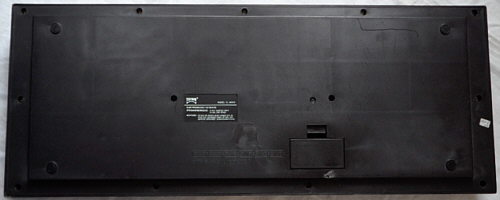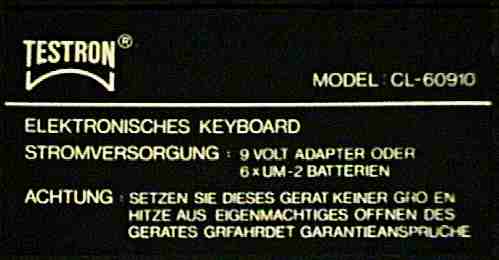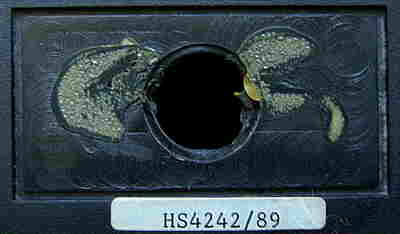 |
 |
 |
 |
CL-60910
squarewave keyboard
with warm C64 sounds & great accompaniment |
|
Elta KE-4
Testron CL-60910
This instrument sounds very similar like the Letron
MC-3, but has a much warmer timbre and a wonderful responsive and
versatile programmed automatic accompaniment.
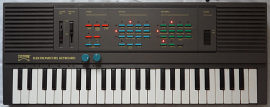
The case is bronze colour and has the German label "ELEKTRONISCHES KEYBOARD"
("electronic keyboard"). It was also released as Elta KE-5, Elta
CL-6091, Electronic Sports Collection ESC KE-5 and Waltham
WE-88. A black case version was released as Plantron DP88, Pantera
PM88 and Eastec ER-460 (seen on eBay).
(Note: This keyboard sounds great, but don't buy one of these
so far your only intention is to get a keyboard with faithfully imitated
natural instrument sounds. Remember, this is a squarewave instrument and
though many of its sounds sound not even remotely like what is written
on its buttons, though bought with wrong expectation it may disappoint
you.)
main features:
-
49 mid size keys
-
polyphony 4 notes (only 1 note with accompaniment, 3 notes with manual
bass)
-
stereo (2x 2W amp with 10 cm speakers)
-
combined rhythm/ accompaniment fader
-
12 OBS preset sounds {piano, trumpet, guitar, accordion, harpsichord, oboe,
music box, violin, clarinet, organ, electric piano, funksynth}
-
12 OBS preset rhythms {pops, country, big band, disco, latin, slow rock,
reggae, bossanova, march, rock'n'roll, 16 beat, waltz}
-
5 percussion sounds {base, conga, snare, open & closed hihat} of unique
electronic style.
| base & conga |
= low & higher squarewave blips |
| snare |
= shift register noise |
| open hihat |
= unique electronic metallic timbre (low- res waveform sample??, or
2 mixed squarewaves?) with truncated decay and audible end click. |
| closed hihat |
= dto. with shorter envelope |
|
|
-
auto- accompaniment in "single finger" chord or "fingered" chord mode (when
rhythm off = manual piano chord keyboard split).
-
manual bass keyboard split (e-bass sound instead of accompaniment)
-
sustain, vibrato and rhythm fill-in buttons
-
transpose buttons (-11 semitone steps, works only in "fingered" or "single
finger" chord mode and affects only main voice)
-
tempo buttons (14 steps?)
-
lots of red, round status LEDs
-
CPU= "NEC D7507CU 234, 8735AY003, Japan" (40 pin SDIL) + sound IC= "Yamaha
YM2163,
78 05 87 G" (24 pin DIL)
-
demo melody "For Elise" (bad sounding monoto)
-
jacks for AC- adapter, headphone, cinch L & R outputs
modifications:
-
2 separate pots for bass and chord volume added.
notes:
Unlike Letron MC-3, the Testron CL-60910
always uses a piano- like envelope for chords. Depending on the rhythm
volume slider position, the chord distorts at the beginning, which creates
a warm sounding sort-of dull fading "wah- wah" filter envelope. The accompaniment
has very interesting arrangements those vary depending on how many chord
keys are pressed, and it does not restrict you to play establishment's
standard chords. Thus e.g. the "country" accompaniment can make great disharmonic
horror/ thriller music by pressing adjacent keys.
When rhythm is off, this instrument also provides a sort-of key split
feature; in "manual bass" mode you can play a monophonic e-bass on the
left (accompaniment) keyboard section and the 3 note polyphonic main voice
on the rest, while in "fingered chord" mode you can play a 3 note polyphonic
piano sound to the left, and the monophonic main voice to the right. The
vibrato is unusually fast. Unfortunately all tones of this crystal clocked
instrument are detuned by about -0.75 semitones and there is no trimmer
to adjust tuning. Like with many old keyboards, the 12 OBS sound buttons
can be also pressed while keys are held down without stopping their notes,
thus theoretically they may be usable as a realtime sound control for arpeggiator-
like timbre changes. Unfortunately the CPU polls the buttons only with
about 4 Hz, which makes them respond much slower and less precise than
in MC-3, and also the silicone rubber buttons are a bit awkward to press
quickly.
Apparently the direct successor of this instrument was the Elta
KE-6. A possible predecessor was the ABA-88.
Elta KE-4
This is a simplified and shorter variant of the Testron
CL-60910. The main model plate of my specimen is missing and there
is only the brand name
Elta and a small paper sticker "HS4242/89"
at the bottom; the "/89" likely indicates that it was released in 1989.
On eBay someone told me that his type plate under an identical looking
instrument was "Model: KE-4 Musical Keyboard Power: USE 6xC-SIZE (UM-2)
Batteries AC ADAPTOR DC 9V 300mA HS2163/89." The "HS2163" may hint
that this model initially had the sound IC Yamaha YM2163.
Later on eBay I saw one with box, telling the official model name Elta
KE-4.
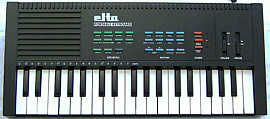
This instrument has only each 8 preset sounds & rhythms, but the
same lovely accompaniment like the Testron, although the bass sounds
less impressive since it uses here a very similar squarewave timbre like
its main voice. Likely here a separate bass sound filter was omitted to
cut cost; also the sound chip is not genuine Yamaha anymore.
different main features:
-
37 mid size keys
-
only 1 speaker (mono)
-
only 8 OBS preset sounds {piano, accordion, trumpet, guitar, music box,
harpsichord, oboe, clarinet}
-
only 8 OBS preset rhythms {pops, big band, disco, country, rock 'n' roll,
16 beat, waltz, march}
-
no rhythm/ accompaniment volume control
-
no sound/ rhythm indicator LEDs
-
bass sounds simpler and less warm (likely by the lack of a separate filter)
-
no demo button
-
CPU= "NEC D7507CU 234, 8734AY007, Japan" (40 pin SDIL) + sound IC= "CW-3163,
8932A" (24 pin DIL | YM2163
clone by Jiahua)
-
jacks for AC- adapter & headphone
eastereggs:
-
Due to the same CPU, the omitted OBS preset sound, rhythms and demo buttons
can be certainly re-added as matrix eastereggs.
| removal
of these screws voids warranty... |
|
|
 |

|
|
| |
back
|
|


